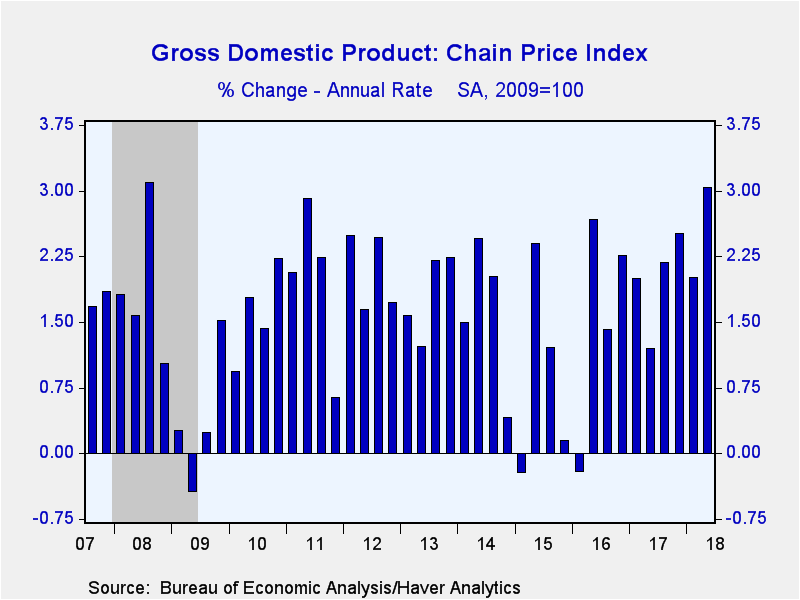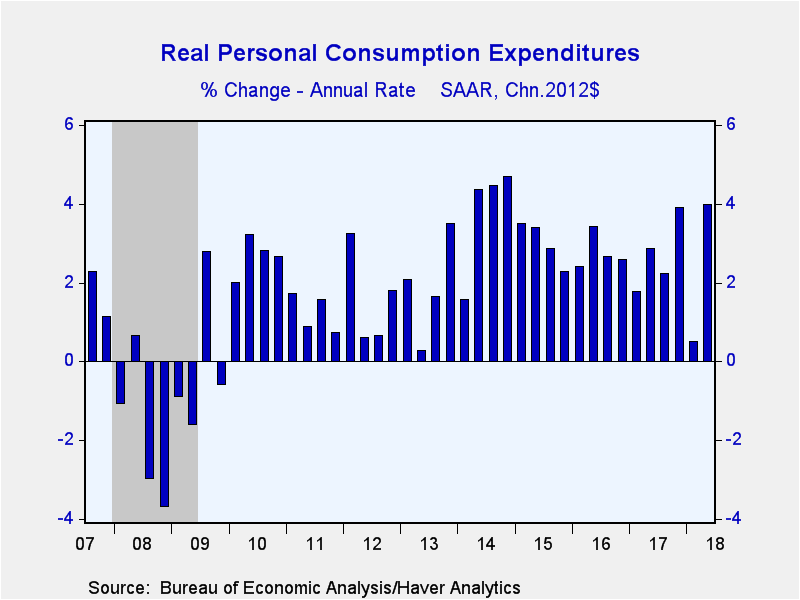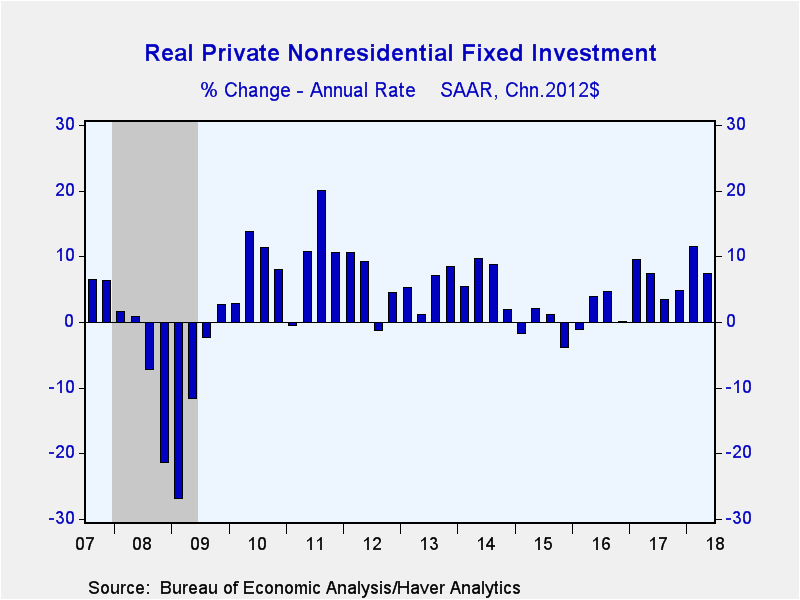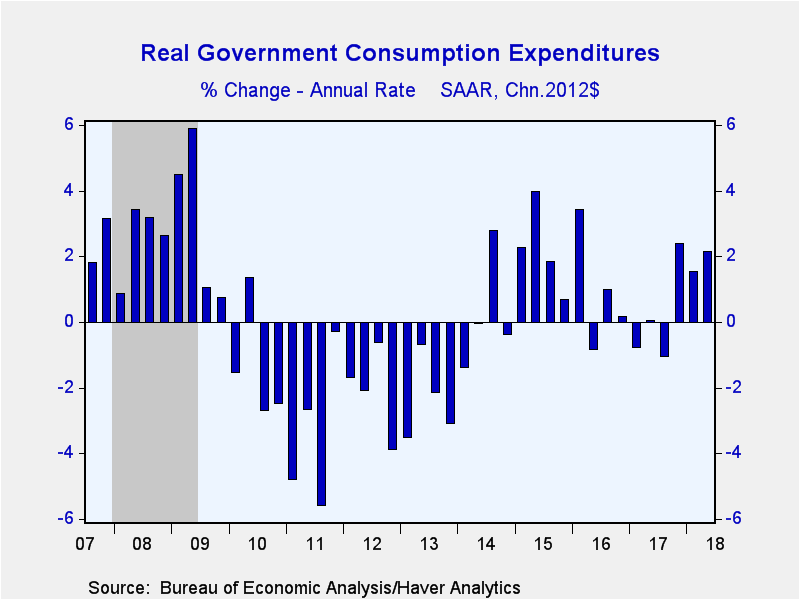 Global| Jul 27 2018
Global| Jul 27 2018U.S. GDP Growth Accelerates
by:Tom Moeller
|in:Economy in Brief
Summary
Real gross domestic product grew 4.1% at an annual rate during Q2'18 (2.8% y/y) following a 2.2% rise during Q1, upwardly revised from 2.0%. It was the strongest increase since Q3'14. The increase matched expectations in the Action [...]
Real gross domestic product grew 4.1% at an annual rate during Q2'18 (2.8% y/y) following a 2.2% rise during Q1, upwardly revised from 2.0%. It was the strongest increase since Q3'14. The increase matched expectations in the Action Economics Forecast Survey. The GDP price index increased 3.0% (2.4% y/y). It was the strongest gain since Q3'08. A 2.3% rise had been expected. This release included comprehensive revisions by the Bureau of Economic Analysis to the GDP series and data, some all the way back to 1929.
Personal consumption expenditures surged 4.0% (2.7% y/y) in Q2, the strongest increase since Q4'14. It was led by a 9.3% surge (6.8% y/y) in spending on durable goods. Motor vehicle buying gained 8.4% (4.6% y/y) and purchases of recreational goods & vehicles surged 8.7% (7.5% y/y). Furniture & appliance spending improved 7.0% (7.3% y/y). Nondurable goods buying advanced 4.2% (2.6% y/y). Clothing purchases strengthened 8.7% (2.9% y/y) and food & beverage spending rose 2.5% (3.5% y/y). Gasoline & fuel oil purchases rose 3.0% (-1.2% y/y). Outlays on services advanced 3.1% (2.0% y/y) led by a 7.1% rise (2.4% y/y) in restaurant & accommodations outlays. Medical care outlays rose 3.5% (3.1% y/y) and recreation spending gained 2.9% (0.2% y/y). Spending on housing & utilities rose 2.4% (1.3% y/y).
Capital spending increased 7.4% (6.7% y/y) led by a 13.3% jump (5.3% y/y) in structures outlays. Equipment investment rose 3.9% (8.0% y/y), paced by a 12.3% jump (10.9% y/y) in information processing equipment. Intellectual property products investment improved 8.2% (6.0% y/y) but outlays on industrial equipment declined 5.3% (+3.3% y/y).
Residential investment eased 1.1% (+1.4% y/y), down for the fourth quarter in the last five.
Government sector outlays increased 2.1% (1.2% y/y) led by a 3.5% gain (2.2% y/y) in outlays by the federal government. National defense spending strengthened 5.5% (2.1% y/y). State & local government spending increased 1.4% (0.7% y/y).
Improvement in the foreign trade deficit added 1.1 percentage points to GDP growth last quarter. Exports surged 9.3% (5.7% y/y) while imports nudged 0.5% higher (4.4% y/y). The change in inventories subtracted 1.0 percentage point from growth.
The chained GDP price index increased 3.0% (2.4% y/y). The residential investment price index surged 7.5% (6.0% y/y). The PCE price index increased 1.8% (2.2% y/y) and the business fixed investment price index rose 2.0% (1.2% y/y). The export price index surged 5.8% (4.9% y/y).
The GDP figures can be found in Haver's USECON and USNA database. USNA contains virtually all of the Bureau of Economic Analysis' detail in the national accounts. Both databases include tables of the newly published not seasonally adjusted data. The Action Economics consensus estimates can be found in AS1REPNA.Preview of the 2018 Comprehensive Update of the National Income and Product Accounts from the Bureau of Economic Analysis is available here.
Tom Moeller
AuthorMore in Author Profile »Prior to joining Haver Analytics in 2000, Mr. Moeller worked as the Economist at Chancellor Capital Management from 1985 to 1999. There, he developed comprehensive economic forecasts and interpreted economic data for equity and fixed income portfolio managers. Also at Chancellor, Mr. Moeller worked as an equity analyst and was responsible for researching and rating companies in the economically sensitive automobile and housing industries for investment in Chancellor’s equity portfolio. Prior to joining Chancellor, Mr. Moeller was an Economist at Citibank from 1979 to 1984. He also analyzed pricing behavior in the metals industry for the Council on Wage and Price Stability in Washington, D.C. In 1999, Mr. Moeller received the award for most accurate forecast from the Forecasters' Club of New York. From 1990 to 1992 he was President of the New York Association for Business Economists. Mr. Moeller earned an M.B.A. in Finance from Fordham University, where he graduated in 1987. He holds a Bachelor of Arts in Economics from George Washington University.












